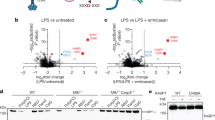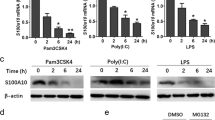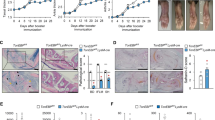Abstract
Toll-like receptors (TLRs) are the best characterized pattern recognition receptors1. Individual TLRs recruit diverse combinations of adaptor proteins, triggering signal transduction pathways and leading to the activation of various transcription factors, including nuclear factor κB, activation protein 1 and interferon regulatory factors2. Interleukin-2 is one of the molecules produced by mouse dendritic cells after stimulation by different pattern recognition receptor agonists3,4,5,6. By analogy with the events after T-cell receptor engagement leading to interleukin-2 production, it is therefore plausible that the stimulation of TLRs on dendritic cells may lead to activation of the Ca2+/calcineurin and NFAT (nuclear factor of activated T cells) pathway. Here we show that mouse dendritic cell stimulation with lipopolysaccharide (LPS) induces Src-family kinase and phospholipase Cγ2 activation, influx of extracellular Ca2+ and calcineurin-dependent nuclear NFAT translocation. The initiation of this pathway is independent of TLR4 engagement, and dependent exclusively on CD14. We also show that LPS-induced NFAT activation via CD14 is necessary to cause the apoptotic death of terminally differentiated dendritic cells, an event that is essential for maintaining self-tolerance and preventing autoimmunity7,8. Consequently, blocking this pathway in vivo causes prolonged dendritic cell survival and an increase in T-cell priming capability. Our findings reveal novel aspects of molecular signalling triggered by LPS in dendritic cells, and identify a new role for CD14: the regulation of the dendritic cell life cycle through NFAT activation. Given the involvement of CD14 in disease, including sepsis and chronic heart failure9,10, the discovery of signal transduction pathways activated exclusively via CD14 is an important step towards the development of potential treatments involving interference with CD14 functions.
This is a preview of subscription content, access via your institution
Access options
Subscribe to this journal
Receive 51 print issues and online access
$199.00 per year
only $3.90 per issue
Buy this article
- Purchase on Springer Link
- Instant access to full article PDF
Prices may be subject to local taxes which are calculated during checkout




Similar content being viewed by others
Accession codes
Primary accessions
Gene Expression Omnibus
Data deposits
All microarray data are available from the Gene Expression Omnibus database (http://www.ncbi.nlm.nih.gov/geo) under accession code GSE15759.
References
Akira, S. Toll-like receptors and innate immunity. Adv. Immunol. 78, 1–56 (2001)
Kaisho, T. & Akira, S. Toll-like receptor function and signaling. J. Allergy Clin. Immunol. 117, 979–987 (2006)
Granucci, F., Feau, S., Angeli, V., Trottein, F. & Ricciardi-Castagnoli, P. Early IL-2 production by mouse dendritic cells is the result of microbial-induced priming. J. Immunol. 170, 5075–5081 (2003)
Guiducci, C., Valzasina, B., Dislich, H. & Colombo, M. P. CD40/CD40L interaction regulates CD4+CD25+ Treg homeostasis through dendritic cell-produced IL-2. Eur. J. Immunol. 35, 557–567 (2005)
Rogers, N. C. et al. Syk-dependent cytokine induction by Dectin-1 reveals a novel pattern recognition pathway for C type lectins. Immunity 22, 507–517 (2005)
Yamazaki, S. et al. Direct expansion of functional CD25+ CD4+regulatory T cells by antigen-processing dendritic cells. J. Exp. Med. 198, 235–247 (2003)
Chen, M. et al. Dendritic cell apoptosis in the maintenance of immune tolerance. Science 311, 1160–1164 (2006)
Stranges, P. B. et al. Elimination of antigen-presenting cells and autoreactive T cells by Fas contributes to prevention of autoimmunity. Immunity 26, 629–641 (2007)
Van Amersfoort, E. S., Van Berkel, T. J. & Kuiper, J. Receptors, mediators, and mechanisms involved in bacterial sepsis and septic shock. Clin. Microbiol. Rev. 16, 379–414 (2003)
Genth-Zotz, S. et al. The anti-CD14 antibody IC14 suppresses ex vivo endotoxin stimulated tumor necrosis factor-α in patients with chronic heart failure. Eur. J. Heart Fail. 8, 366–372 (2006)
Beutler, B. et al. Genetic analysis of host resistance: Toll-like receptor signaling and immunity at large. Annu. Rev. Immunol. 24, 353–389 (2006)
Winzler, C. et al. Maturation stages of mouse dendritic cells in growth factor-dependent long-term cultures. J. Exp. Med. 185, 317–328 (1997)
Kawasaki, K., Gomi, K., Kawai, Y., Shiozaki, M. & Nishijima, M. Molecular basis for lipopolysaccharide mimetic action of Taxol and flavolipin. J. Endotoxin Res. 9, 301–307 (2003)
Suzuki, K. G. et al. GPI-anchored receptor clusters transiently recruit Lyn and Gα for temporary cluster immobilization and Lyn activation: single-molecule tracking study 1. J. Cell Biol. 177, 717–730 (2007)
Carpenter, G. & Ji, Q. Phospholipase C-γ as a signal-transducing element. Exp. Cell Res. 253, 15–24 (1999)
Pugin, J. et al. Cell activation mediated by glycosylphosphatidylinositol-anchored or transmembrane forms of CD14. Infect. Immun. 66, 1174–1180 (1998)
Kinoshita, T., Fujita, M. & Maeda, Y. Biosynthesis, remodelling and functions of mammalian GPI-anchored proteins: recent progress. J. Biochem. 144, 287–294 (2008)
Moore, K. J. et al. Divergent response to LPS and bacteria in CD14-deficient murine macrophages. J. Immunol. 165, 4272–4280 (2000)
Haziot, A. et al. Resistance to endotoxin shock and reduced dissemination of gram-negative bacteria in CD14-deficient mice. Immunity 4, 407–414 (1996)
Jiang, Z. et al. CD14 is required for MyD88-independent LPS signaling. Nature Immunol. 6, 565–570 (2005)
Kagan, J. C. et al. TRAM couples endocytosis of Toll-like receptor 4 to the induction of interferon-β. Nature Immunol. 9, 361–368 (2008)
Shakhov, A. N., Collart, M. A., Vassalli, P., Nedospasov, S. A. & Jongeneel, C. V. κB-type enhancers are involved in lipopolysaccharide-mediated transcriptional activation of the tumor necrosis factor α gene in primary macrophages. J. Exp. Med. 171, 35–47 (1990)
Dendorfer, U. Molecular biology of cytokines. Artif. Organs 20, 437–444 (1996)
Aramburu, J. et al. Affinity-driven peptide selection of an NFAT inhibitor more selective than cyclosporin A. Science 285, 2129–2133 (1999)
Schuh, K. et al. Retarded thymic involution and massive germinal center formation in NF-ATp-deficient mice. Eur. J. Immunol. 28, 2456–2466 (1998)
Mahnke, K., Qian, Y., Knop, J. & Enk, A. H. Induction of CD4+/CD25+ regulatory T cells by targeting of antigens to immature dendritic cells. Blood 101, 4862–4869 (2003)
Dobrovolskaia, M. A. & Vogel, S. N. Toll receptors, CD14, and macrophage activation and deactivation by LPS. Microbes Infect. 4, 903–914 (2002)
Medzhitov, R. Origin and physiological roles of inflammation. Nature 454, 428–435 (2008)
Granucci, F. et al. Inducible IL-2 production by dendritic cells revealed by global gene expression analysis. Nature Immunol. 2, 882–888 (2001)
Schreiber, E., Matthias, P., Muller, M. M. & Schaffner, W. Rapid detection of octamer binding proteins with 'mini-extracts', prepared from a small number of cells. Nucleic Acids Res. 17, 6419 (1989)
Granucci, F. et al. The scavenger receptor MARCO mediates cytoskeleton rearrangements in dendritic cells and microglia. Blood 102, 2940–2947 (2003)
Irizarry, R. A. et al. Exploration, normalization, and summaries of high density oligonucleotide array probe level data. Biostatistics 4, 249–264 (2003)
Gentleman, R. C. et al. Bioconductor: open software development for computational biology and bioinformatics. Genome Biol. 5, R80 (2004)
Acknowledgements
We thank S. Akira, C. Kirschning and K. Miyake for mutant mice; M. Colonna for mutant mice and advice on PLC-γ2 activation; E. Serfling for mutant mice and advice on NFAT activation; A. Rao for the VIVIT peptide. We also thank Genopolis–Consorzio di Genomica Funzionale for microarray hybridization and data analysis and K. Mahnke for the anti-DEC205–OVA conjugate. This work was supported by grants from the CARIPLO Foundation, the European Commission 6th Framework Program (MUGEN and DC-THERA contracts), the European Commission 7th Framework Program (TOLERAGE and ENCITE contracts), the Associazione Italiana per la Ricerca sul Cancro (AIRC) and the and the Italian Ministry of Education and Research (COFIN).
Author Contributions F.G. conceived and oversaw the project and wrote the paper; I.Z. conceived the research and conducted most of the experiments with R.O.; M.C., M.C., M.R., G.C., B.C. and A.Z. helped with calcium experiments; G.C. and F.M. helped with experiments on D1 cells; M.F. helped with quantitative real-time PCR; A.E.R. performed the EMSA experiments; P.R.-C. provided advice.
Author information
Authors and Affiliations
Corresponding author
Supplementary information
Supplementary Information
This file contains Supplementary Figures S1-S14, Supplementary Tables 1-2 and Supplementary References. (PDF 3307 kb)
Supplementary Movie 1
Movie BMDC_ATP shows Ca2+ mobilization in BMDCs after steady-state superfusion with ATP. (MOV 2391 kb)
Supplementary Movie 2
Movie BMDC_LPS shows Ca2+ mobilization in BMDCs after steady-state superfusion with LPS. (MOV 1823 kb)
Supplementary Movie 3
Movie DI_ATP shows Ca2+ mobilization in D1 cells after steady-state superfusion with ATP. (MOV 3312 kb)
Supplementary Movie 4
Movie DI_LPS shows Ca2+ mobilization in D1 cells after steady-state superfusion with LPS. (MOV 2042 kb)
Rights and permissions
About this article
Cite this article
Zanoni, I., Ostuni, R., Capuano, G. et al. CD14 regulates the dendritic cell life cycle after LPS exposure through NFAT activation. Nature 460, 264–268 (2009). https://doi.org/10.1038/nature08118
Received:
Accepted:
Published:
Issue Date:
DOI: https://doi.org/10.1038/nature08118
This article is cited by
-
Vaccination in patients with kidney failure: lessons from COVID-19
Nature Reviews Nephrology (2022)
-
Externalized phosphatidylinositides on apoptotic cells are eat-me signals recognized by CD14
Cell Death & Differentiation (2022)
-
Sulfavant A as the first synthetic TREM2 ligand discloses a homeostatic response of dendritic cells after receptor engagement
Cellular and Molecular Life Sciences (2022)
-
Pimecrolimus interferes the therapeutic efficacy of human mesenchymal stem cells in atopic dermatitis by regulating NFAT-COX2 signaling
Stem Cell Research & Therapy (2021)
-
Dissecting immune cell stat regulation network reveals biomarkers to predict ICB therapy responders in melanoma
Journal of Translational Medicine (2021)
Comments
By submitting a comment you agree to abide by our Terms and Community Guidelines. If you find something abusive or that does not comply with our terms or guidelines please flag it as inappropriate.



